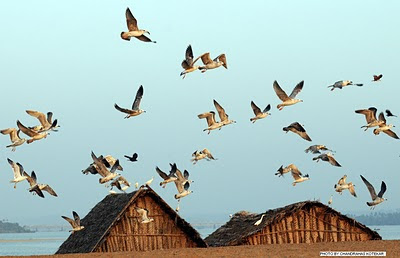 As winter opens itself to the world, Kotepura on the outskirts of Mangalore turns a heaven for migratory birds. Apart from the roar of mighty waves from a little far, the confluence of river Netravathi and the Arabian Sea fills with the chirping and flight of thousands of birds, adding colors to the estuary’s beauty.
As winter opens itself to the world, Kotepura on the outskirts of Mangalore turns a heaven for migratory birds. Apart from the roar of mighty waves from a little far, the confluence of river Netravathi and the Arabian Sea fills with the chirping and flight of thousands of birds, adding colors to the estuary’s beauty.Though the period between November to February is considered the ‘season’ of migratory birds in Mangalore, birds start descending on the Port City from early September itself which may continue up to April. According to ornithologist Dr N A Madhyastha, Golden Plovers (Pluvialis fulva) arrive in Mangalore exactly on August 30 every year.
“Golden plover is the most important migratory bird of the coastal districts. It is the one that travels the second highest distance among the migratory birds. The bird’s biological clock is so punctual that it reaches the district on August 30 every year after flying for about 5,000 kms,” observes Dr Madhyastha.
Black-Headed Gull, Great White Egret and Herons are the other significant migratory birds found in Kotepura. The black-headed gull (Chroicocephalus ridibundus) sports black feathers on its head and on the tips of its wings. It is considered a bold, an opportunist feeder and a noisy species. Insects, fish, seeds and worms form its food.
The Great Egret (Ardea alba) is a large bird with all-white plumage. It feeds in shallow water or drier habitats, feeding mainly on fish, frogs, small mammals, and occasionally small birds and reptiles. It will often wait motionless for prey, or slowly stalk its victim. Unlike Black-Headed Gull, Egret is normally not a vocal bird.
Herons (Ardeidae) are mainly white in color; they may have decorative plumes too. They are essentially non-swimming water birds. Their diet includes a wide variety of aquatic animals, including fish, reptiles, amphibians, crustaceans, mollusks and aquatic insects.

According to Dr Madhyastha, a total of 33 species of migratory birds arrive in the undivided Dakshina Kannada district including Lesser Sand Plover, Red Shank, Green Shank, Marsh Sandpiper, Green Sandpiper, Wood Sandpiper, Black Winged Stilt, Common Sand Piper, Little Pratincole, Grey Plover, Black-Tailed Godwit and Turnstone.
These birds come to Mangalore from north and central Europe, Siberia, Himalayan ranges and beyond, Ladakh, Pakistan and Afghanistan. “There are two types of migratory birds, i.e., transient migrants (which alight in a place on their way to south) and regular visitors (which arrive every year in a particular place and stay for a few months). The coastal districts have both the kinds of birds,” says Dr Madhyastha.
Kotepura houses a fishing jetty and even fish processing factories. Hence, the migratory birds, which primarily feed on aquatic animals, have selected this estuary as their favorite habitat. Due to the tidal variation and a unique blend of sweet water and salt water, the estuaries prove to be the best source of food for these kinds of birds.
Experts are of the view that excessive use of pesticides, insecticides and chemical fertilizers have affected the number of birds arriving in Mangalore during winter. “Many species might have changed their destination for various reasons; but increased use of pesticides has certainly affected,” notes the ornithologist.
Still, Mangalore is a favorite hotspot of migratory birds, and one can wish that this advantage of the region could be well exploited to transform it into a vibrant tourist destination.

(My sincere thanks to our photojournalist Mr Chandrahas Kotekar for his beautiful photographs)
2 ಕಾಮೆಂಟ್ಗಳು:
appa paddu...
hegiddeeya?
magalu hegiddaale?maataadtaala?
mane tumbaaa odaaadtaalaa?
Manikanth
namnantha english baarada mandigaagi kannadadalli hechchu bareyalu praythnisi pls... adu baaree bega artha aagutte nodi...!!
ಕಾಮೆಂಟ್ ಪೋಸ್ಟ್ ಮಾಡಿ